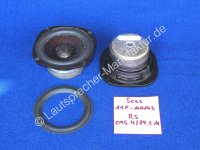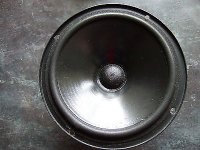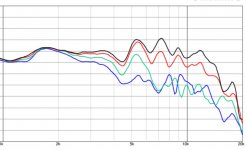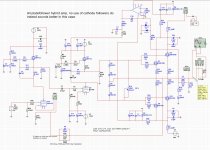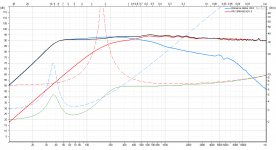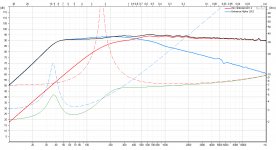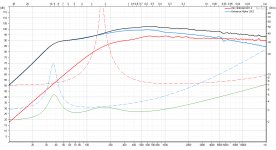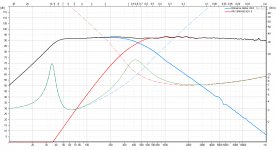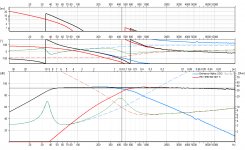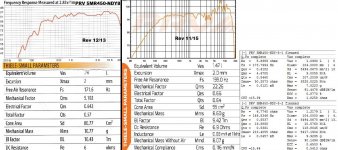I have two seas mids 11F-M I need to repair surrounds but maybe it can be used in a tractrix who also have a K-tube for spreading hf.
Also I have two mission bass but these can better be sold or maybe for future project not for horns..
Also I have two mission bass but these can better be sold or maybe for future project not for horns..
Attachments
Member
Joined 2009
Paid Member
For
a) "high sensitivity, making it suitable for a low power (tube) amp"
b) avoiding "ear bleeding" treble
...if you were going to consider wide band units (300Hz - 6kHz or thereabouts), the Audax PR170M0 might be another option to look at. Slightly more efficient, and apparently a bit smoother than the PRV. The higher impedance could be a good thing with tube amps. Used in jillions of systems.
The only drawback I see is the 2cm increase in radius.
I don't consider a 3-way to be of interest, too many drivers.
The one thing that can occassionaly save my ears is toe-out for drivers that lose their treble peaks off-axis.
Last edited:
Member
Joined 2009
Paid Member
I wonder if the Galaxy Neolite S5n-8 would be worth looking atbas an alternative to the PRV, if it might be less peaky in the treble.http://www.parts-express.com/pedocs/specs/290-020-galaxy-audio-s5n-8-specifications.pdf
I wonder if the Galaxy Neolite S5n-8 would be worth looking atbas an alternative to the PRV, if it might be less peaky in the treble.http://www.parts-express.com/pedocs/specs/290-020-galaxy-audio-s5n-8-specifications.pdf
I had this driver suggested once, but looking at the "Sample Response Graphs" on the Parts Express page dissuaded me: a general lift above 2kHz plus a big spike at 6kHz - it seems too much like the Fostex driver I was trying to improve upon. It doesn't look like an improvement on the PRV driver.
All the higher efficiency drivers of this type seem to have some treble anomalies. You either live with them, or use a mid+tweeter instead, or go for a less efficiency (such as the Scan Speak 4" fullranger).
In my experience*, the P.Audio SN4-60F is a good driver of this type - same efficiency and bandwidth as the Fostex 105WK, but the HF glitches are much more benign (not fatiguing). The big caveat being that 1 out of the 4 drivers SN4-60F I got was faulty; it sounds fine, but has higher Qes, and lower efficiency, presumably from an under-charged magnet. These units sound good enough that I haven't been motivated to buy a replacement - nothing that's similar (efficiency, size, bandwidth) seems to measure any better.
http://www.diyaudio.com/forums/full-range/275899-paper-cone-open-frame-driver-front-horn.html
Also: if you can acquire and test junk speakers, you might find that some cheap & unlikely looking drivers sound as good as the relatively costly stuff. I once built a project to use the 105WK - but eventually used a speaker from a TV that was the same size, and lots easier to listen to.
*I've tried about a dozen drivers of this type, most of them being cheap / salvage units. There seems to be no relationship at all between how good a driver looks and sounds.
For good sound low price and 91dB the Dayton PA130-8 is a nice alternative. I really enjoy its natural sound - not fatiguing at all. It can also achieve some decent bass too - something these stiff suspension mid drivers cannot do.
Member
Joined 2009
Paid Member
If that is PA130-8 - it doesn't bother my ears upon listening. Once off axis a bit not a problem. Really, they are one of my favorite drivers. I have four of them in two different speakers. Listen to them almost daily.
X If I use the horns in a corner or agains the wall, I can make the horn smaller for the same output reach?, this is because in a home it is always on a wall or corner.
I can then make a 350 hz cuttoff horn who is smaller then I have now and is more easy to get in room.
I can then make a 350 hz cuttoff horn who is smaller then I have now and is more easy to get in room.
Here is the horn:
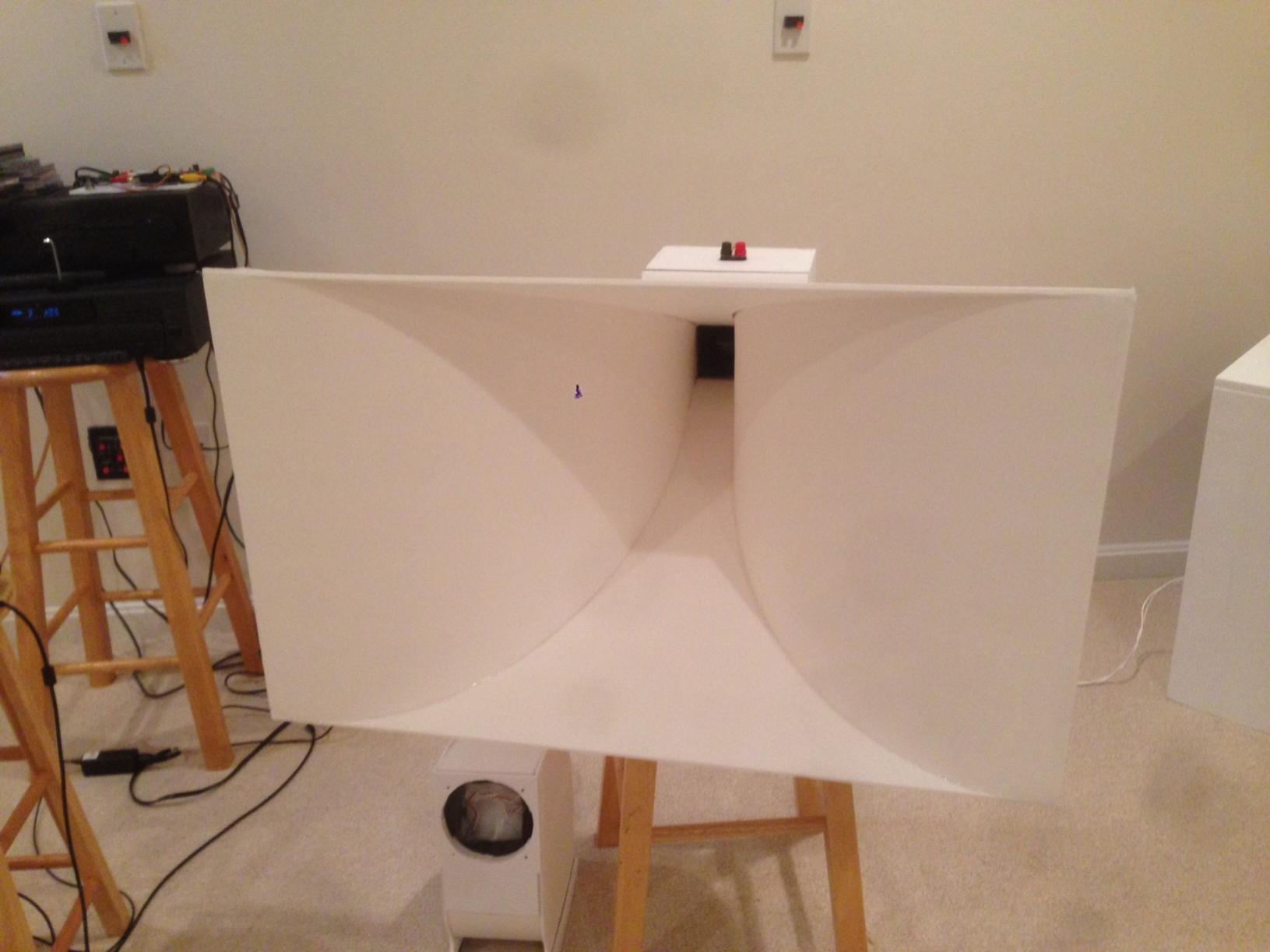
Did you try the TC9FD in this tractrix horn ? If so did you plot the response ?
Thanks.
Member
Joined 2009
Paid Member
I must admit, I've become much less interested in tube based power amps because of the limitations on driver choices. I have output transformers to build two amps which will be fun but after that I don't see myself using tubes at the output. Tubes at the input is another story ;-)
I must admit, I've become much less interested in tube based power amps because of the limitations on driver choices. I have output transformers to build two amps which will be fun but after that I don't see myself using tubes at the output. Tubes at the input is another story ;-)
The best sounding hybrid I had made, only plate followers and one source follower on dual mu stage, with or without (current) feedback.
Attachments
Member
Joined 2009
Paid Member
Actually, it would be interesting to hear the PRV off-axis, it could redeem this option for people with sensitive ears like mine.
Resurrecting thread per PM to xrk971. After weeks of reading plenty threads and some advice of various forum members, the PRV 5MR450-NDY seems to be the best compromise relative to expensive full rangers like Audio Nirvana or others with difficult peaks to work with. I will add this is my first DIY so ignorance is rated as high so forgive my questions or attempts at the xover approach.
My design for an OB is a baffle 400 mm x 900 -950 mm with 2 15" Alpha's and 1 5MR450-NDY - all 8 ohms with the Alpha's in parallel.
Using Basta, my starting point is the 3 drivers on my baffle with no xover:
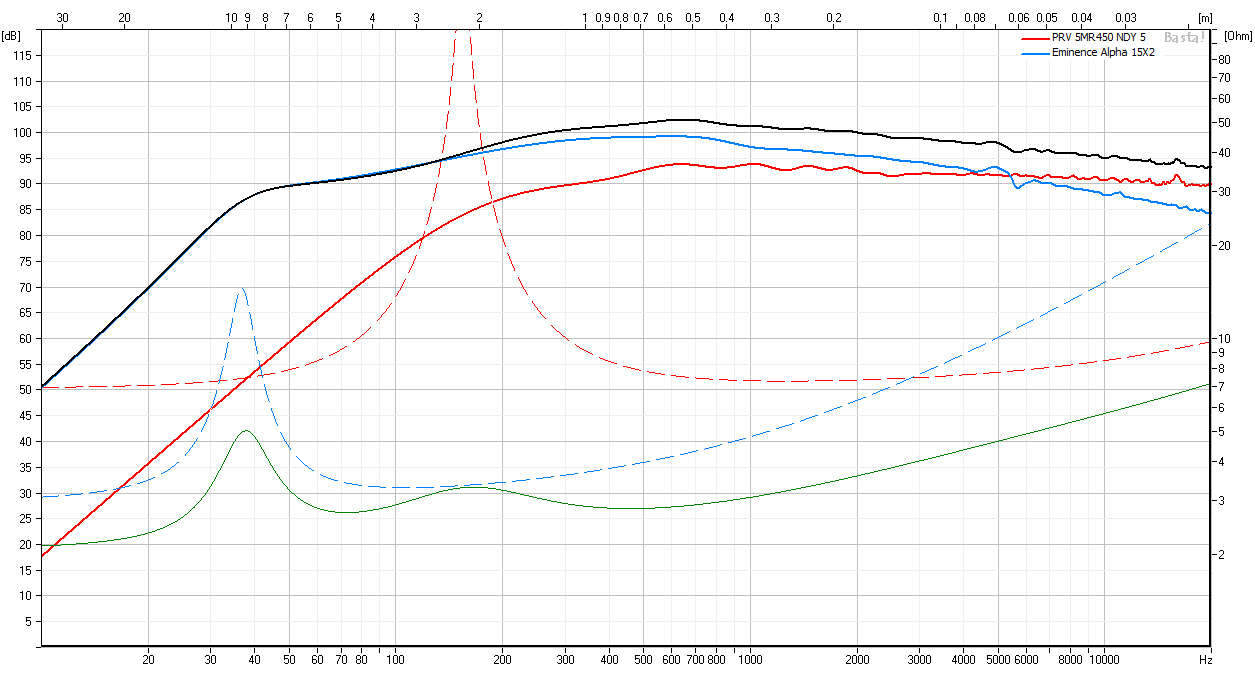
First order low pass on woofer only 2.7 mH
http://www.diyaudio.com/forums/attachment.php?attachmentid=642864&stc=1&d=1509315287
Second order low pass on woofer only 2.9 mH + 2 uF
http://www.diyaudio.com/forums/attachment.php?attachmentid=642865&stc=1&d=1509315287
Second order low pass on woofer 4.3 mH + 118 uF and second order high pass on full range 26 uF + 2.1 mH
http://www.diyaudio.com/forums/attachment.php?attachmentid=642866&stc=1&d=1509315314
Am I on the right track ? Any suggestions to make this better or easier to implement as I'd like to order the drivers and as I'm in Australia this is going to be an expensive mini-project as I intend to build 3 speakers for L + C + R with the L + R having an offset full ranger and the C with a centered full ranger (which doesn't seem to peak/vary too much based on my modelling but top priority is getting the 2 channel right).
BTW - I am not adverse to going miniDSP but this will complicate things as all my gear is at the back of the room with in-wall/in-ceiling cabling to the front so all I have for line-outs is L+R which is actually for sub-woofer duty. Active xover will entail getting another 3 channel amp assuming the centre will be passive and the L + R will use 4 of my 5 power amp channels.
Thanks !
My design for an OB is a baffle 400 mm x 900 -950 mm with 2 15" Alpha's and 1 5MR450-NDY - all 8 ohms with the Alpha's in parallel.
Using Basta, my starting point is the 3 drivers on my baffle with no xover:
First order low pass on woofer only 2.7 mH
http://www.diyaudio.com/forums/attachment.php?attachmentid=642864&stc=1&d=1509315287
Second order low pass on woofer only 2.9 mH + 2 uF
http://www.diyaudio.com/forums/attachment.php?attachmentid=642865&stc=1&d=1509315287
Second order low pass on woofer 4.3 mH + 118 uF and second order high pass on full range 26 uF + 2.1 mH
http://www.diyaudio.com/forums/attachment.php?attachmentid=642866&stc=1&d=1509315314
Am I on the right track ? Any suggestions to make this better or easier to implement as I'd like to order the drivers and as I'm in Australia this is going to be an expensive mini-project as I intend to build 3 speakers for L + C + R with the L + R having an offset full ranger and the C with a centered full ranger (which doesn't seem to peak/vary too much based on my modelling but top priority is getting the 2 channel right).
BTW - I am not adverse to going miniDSP but this will complicate things as all my gear is at the back of the room with in-wall/in-ceiling cabling to the front so all I have for line-outs is L+R which is actually for sub-woofer duty. Active xover will entail getting another 3 channel amp assuming the centre will be passive and the L + R will use 4 of my 5 power amp channels.
Thanks !
Attachments
Jklow,
Very nice work. You have obviously put some thought into this. I personally like how first order crossovers can sound if there is not too much cone breakup leaking through. Are your simulations using actual data for the responses? Probably not as it shows PRV going all the way up to 20khz. It falls off at 15khz in reality.
I like this:
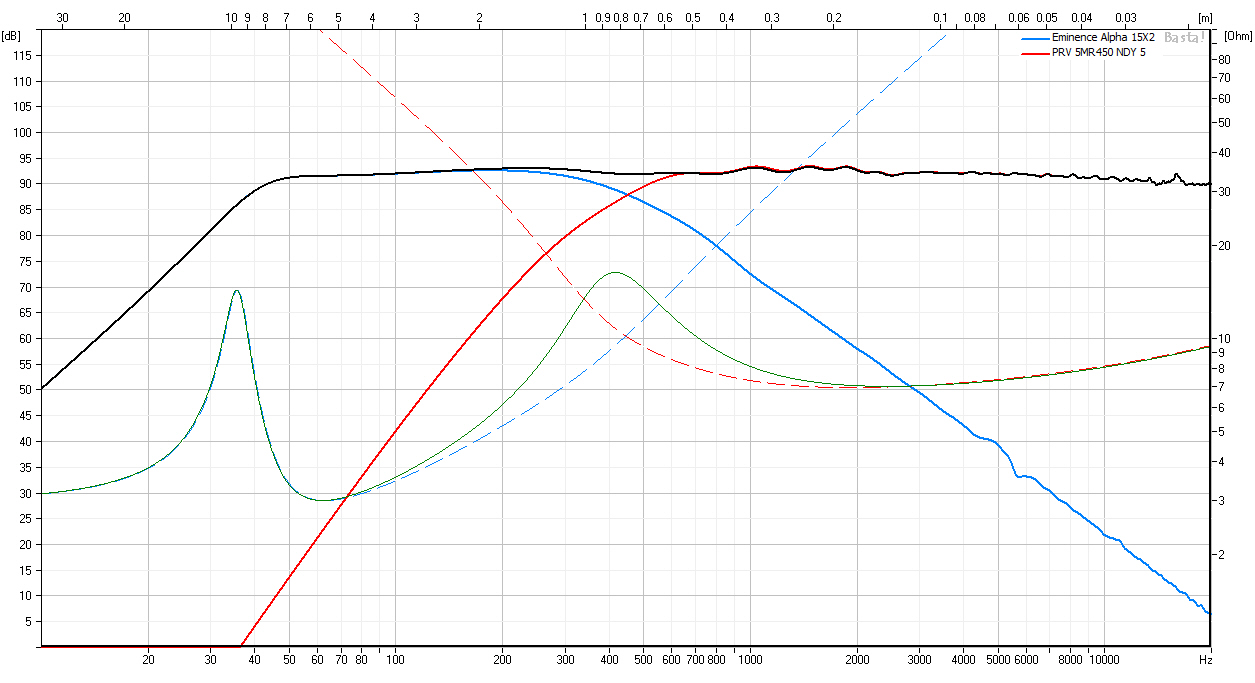
So what you can do to more accurately model these including breakup modes and real responses is to use a program that imports the FRD files for these drivers and simulates crossovers based on that. Examples include Xsim by member Bwaslo or PCD excel spreadsheet by Jeff Bagby. Both programs let you simulate either a passive crossover or an active one using filter banks available in miniDSP. MiniDSP is a great way to go, but as you say, will require additional wires to be pulled in the wall. Parts cost of minDSP will be less than passive crossover in my experience if you have double set of amps already.
My guess is that there will be a lot of breakup and the 2nd order will sound cleaner. The only problem with 2nd order crossovers vs 1st order is the phase and lack of transient perfect step response. Maybe not an issue for you. If using minDSP, please look into Harsch XO. A 4th order on woofer and Bessel on full range with a special delay to allow quasi-transient perfect response. I use it almost exclusively if going active with miniDSP.
S. Harsch XO
Schematically, it looks like this:
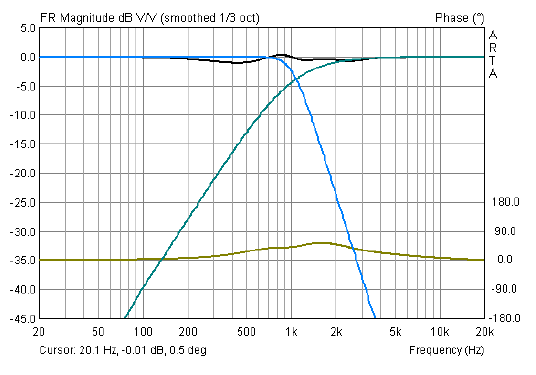
Very nice work. You have obviously put some thought into this. I personally like how first order crossovers can sound if there is not too much cone breakup leaking through. Are your simulations using actual data for the responses? Probably not as it shows PRV going all the way up to 20khz. It falls off at 15khz in reality.
I like this:
So what you can do to more accurately model these including breakup modes and real responses is to use a program that imports the FRD files for these drivers and simulates crossovers based on that. Examples include Xsim by member Bwaslo or PCD excel spreadsheet by Jeff Bagby. Both programs let you simulate either a passive crossover or an active one using filter banks available in miniDSP. MiniDSP is a great way to go, but as you say, will require additional wires to be pulled in the wall. Parts cost of minDSP will be less than passive crossover in my experience if you have double set of amps already.
My guess is that there will be a lot of breakup and the 2nd order will sound cleaner. The only problem with 2nd order crossovers vs 1st order is the phase and lack of transient perfect step response. Maybe not an issue for you. If using minDSP, please look into Harsch XO. A 4th order on woofer and Bessel on full range with a special delay to allow quasi-transient perfect response. I use it almost exclusively if going active with miniDSP.
S. Harsch XO
Schematically, it looks like this:

Thanks ! Simulations are only in Basta per TS parameters for each driver. I think it will take plenty time for me to wrap my head around getting and using actual FRD/ZMA data.
I started looking at coils and caps and the 100 uF+ ones are expensive (relatively speaking) so I started modelling the cross over to use a lower cap yet still get a smooth outcome as well as moved to a slightly larger baffle of 450 mm x 1000 mm. I wish I had 2 pairs of line outs as that would let me go active but pre-cabling is all done now.
Whilst not an expert, I do think 2nd order is better to reduce any breakup from the woofer.
Can you elaborate on this ?
I started looking at coils and caps and the 100 uF+ ones are expensive (relatively speaking) so I started modelling the cross over to use a lower cap yet still get a smooth outcome as well as moved to a slightly larger baffle of 450 mm x 1000 mm. I wish I had 2 pairs of line outs as that would let me go active but pre-cabling is all done now.
Whilst not an expert, I do think 2nd order is better to reduce any breakup from the woofer.
The only problem with 2nd order crossovers vs 1st order is the phase and lack of transient perfect step response. Maybe not an issue for you.
Can you elaborate on this ?
In your simulation program is there an option to look at the predicted step response? A step response for a transient perfect speaker will have all drivers firing in the same direction and at the same time (in phase) to produce an impulse step response that looks like a step function. In practice it has some decay since a speaker has finite lower bandwidth, so the step looks like a right triangle. On a non transient perfect speaker, this response doesn't look anything like a step. It may look like a messy oscillation and the peaks may be going negative when they should be positive. Very few multiway speakers succeed at being transient perfect. Well, all single driver full range speakers naturally do it - which is why they sound temporally accurate. But they lack bass extension so the right triangle of the step is very short. Properly implemented 1st order xo's are transient perfect. B&O's "hole filler" xo is a transient accurate 3 way. The Dunlavey SC-IV is transient perfect.
So why the hubbub on being transient perfect? It plays percussive sounds accurately and sounds more real. Piano, kick drums, guitar, bass, castanets, hand claps, drum rim shots, etc. once you hear it you will know it. If you don't hear it, you won't know what you are missing. Many people who design multiway speakers simple give up on it because it places such a heavy limitation on what xo's can be used and where the drivers have to be on a baffle. Generally a stepped baffle or tilted baffle is needed. But with DSP a flat baffle can be used and delays all done digitally to achieve same thing.
Read the Stereophile review (measurements) of the Dunlavey SC-IV to understand how rare transient perfect is. I think John Atkinson said he could count on one hand how many speakers he has tested that are.
Dunlavy Audio Laboratories SC-IV loudspeaker Measurements | Stereophile.com
Here is measured step response of Dunlavey:
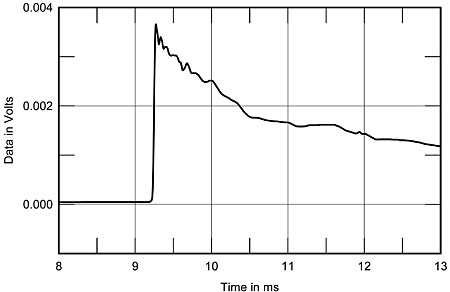
By contrast, here is step response of a very highly regarded and expensive speaker, the B&W 804D:
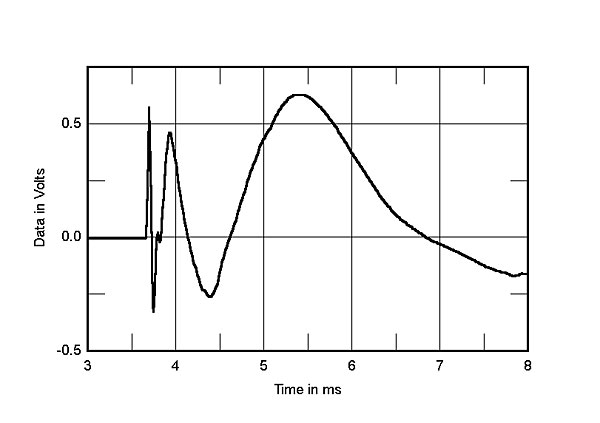
Bowers & Wilkins 804 Diamond loudspeaker Measurements | Stereophile.com
Which one do you think sounds more temporally accurate?
Here is the step response from my FAST speaker with passive 1st order xo:
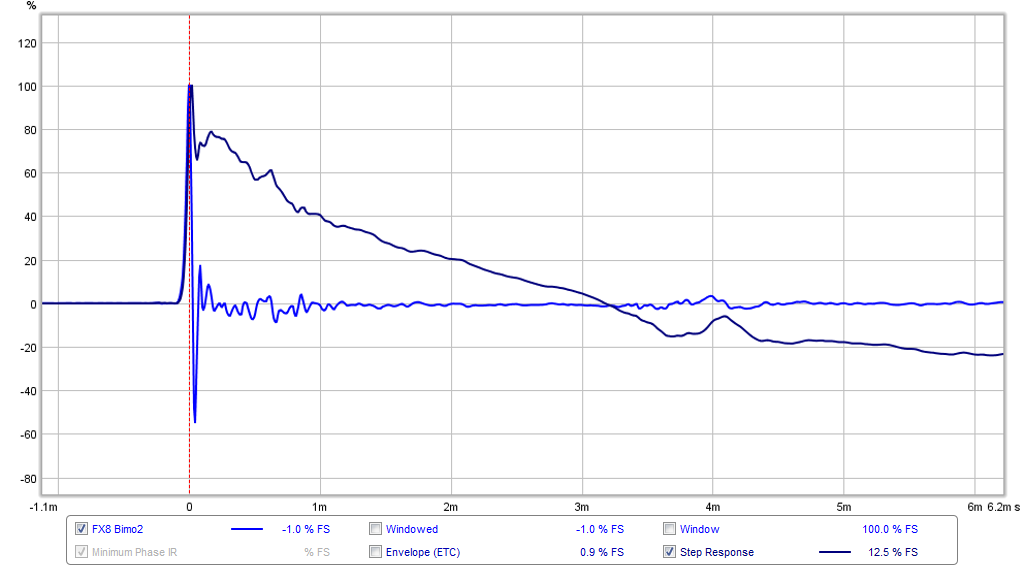
So why the hubbub on being transient perfect? It plays percussive sounds accurately and sounds more real. Piano, kick drums, guitar, bass, castanets, hand claps, drum rim shots, etc. once you hear it you will know it. If you don't hear it, you won't know what you are missing. Many people who design multiway speakers simple give up on it because it places such a heavy limitation on what xo's can be used and where the drivers have to be on a baffle. Generally a stepped baffle or tilted baffle is needed. But with DSP a flat baffle can be used and delays all done digitally to achieve same thing.
Read the Stereophile review (measurements) of the Dunlavey SC-IV to understand how rare transient perfect is. I think John Atkinson said he could count on one hand how many speakers he has tested that are.
Dunlavy Audio Laboratories SC-IV loudspeaker Measurements | Stereophile.com
Here is measured step response of Dunlavey:

By contrast, here is step response of a very highly regarded and expensive speaker, the B&W 804D:

Bowers & Wilkins 804 Diamond loudspeaker Measurements | Stereophile.com
Which one do you think sounds more temporally accurate?
Here is the step response from my FAST speaker with passive 1st order xo:

Last edited:
Thought this might help...
I recently bought a pair in July. I had a bad unit that scraped, and got a new replacement free of charge. Due to this, I was able to keep and autopsy the 5MR450-NDY. You'll all be glad to know that it has a full copper sleeve. This is definitely a high class driver with an open magnet structure and low HD. The gaps between the neo slugs are not sealed and do pass air.
I also noticed that there are 2 versions of the spec sheet, of which I paired with my measured T/S of the drivers. I flexed them by hand to loosen them up a bit before taking the specs.
The representative at MWAF stated that many people were using these full range and she recommended that I at least try it. I will try it, but it'll ultimately be destined for a TMWW with the Visaton MHT12, and a pair of Audax HM170Z18 woofers. It was the only 5" driver I found that had the frame as the others in this system do, the FR to meet the MHT12, and the sensitivity to keep up with a pair of the HM170Z18 woofers without requiring 2 mids.
More on that in another thread when I get there....
See attached for measured info,
Wolf
I recently bought a pair in July. I had a bad unit that scraped, and got a new replacement free of charge. Due to this, I was able to keep and autopsy the 5MR450-NDY. You'll all be glad to know that it has a full copper sleeve. This is definitely a high class driver with an open magnet structure and low HD. The gaps between the neo slugs are not sealed and do pass air.
I also noticed that there are 2 versions of the spec sheet, of which I paired with my measured T/S of the drivers. I flexed them by hand to loosen them up a bit before taking the specs.
The representative at MWAF stated that many people were using these full range and she recommended that I at least try it. I will try it, but it'll ultimately be destined for a TMWW with the Visaton MHT12, and a pair of Audax HM170Z18 woofers. It was the only 5" driver I found that had the frame as the others in this system do, the FR to meet the MHT12, and the sensitivity to keep up with a pair of the HM170Z18 woofers without requiring 2 mids.
More on that in another thread when I get there....
See attached for measured info,
Wolf
Attachments
- Home
- Loudspeakers
- Full Range
- PRV 5MR450-NDY for FAST/WAW applications
